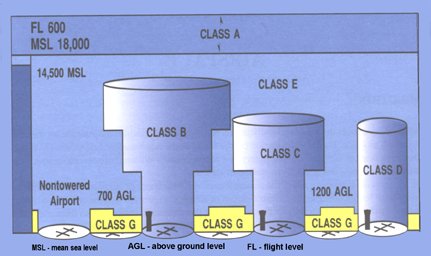airspace

Airspace is a three-dimensional area described in terms of altitude as well as by other characteristics such as whether it is above an urban or remote area. Airspace is broken into the two broad groups – controlled and uncontrolled airspace – then into Class A - Class G. Class A - Class E designate controlled airspace. Class G designates uncontrolled airspace. Class F is not used in the United States but is used elsewhere in the world. Classes of airspace are marked on aeronautical charts.
All airspace classes have specific rules for flight with aircraft instruments and flight using visual navigation beginning at sea level and continuing to 60,000 feet (18,288 meters) above sea level. Except in Class A airspace, pilots may fly using either instrument or visual rules. Class A airspace begins at 18,000 feet (5,486 meters) above mean sea level (MSL), and only aircraft using instrument rules for navigation can safely and legally operate there.
Above an airport or urban area, stricter rules and more procedures apply to planes flying closer to the ground. These rules often get less strict the higher the pilot flies, forming invisible circular tiers that widen with altitude. The result is a series of what many pilots think of as upside-down wedding cakes, with shapes that vary depending on the size of the airport or the nearest urban area or obstruction.
All airspace classes require certain pilot qualifications, aircraft equipment, airspeeds and altitudes, clearance from clouds, and communication procedures. In addition, each controlled airspace class sets additional requirements and is subject to one of the more than 20,000 federal air traffic controllers or the hundreds of pages of rules in the Federal Aviation Regulations.
Even in uncontrolled airspace and at uncontrolled airports, minimum rules apply, though pilots can largely decide their own direction of flight and approach to landing. In uncontrolled airspace, visual flight rules require pilots to meet minimum requirements for good weather and visibility, fly at certain altitudes, and to stay a minimum distance from clouds.
The largest area of controlled airspace is called the continental control area. This is the airspace above the 48 contiguous United States and Alaska and the waters within 12 nautical miles (22 kilometers) of the coast. It begins at 14,500 feet (4,420 meters) above MSL.
Special use airspace exists where activities must be confined because of their nature. Aircraft that are not a part of the activities that take place within special use airspace may not be allowed in it. Special use airspace consists of prohibited areas, restricted areas, warning areas, military operation areas, alert areas, and controlled firing areas. These areas are clearly depicted on aeronautical charts.


